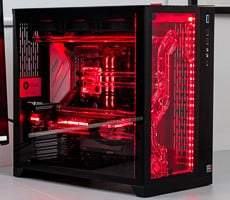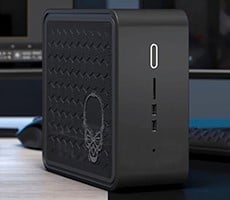Lenovo ThinkStation S20 Workstation Review
IBM has been a name synonymous with computers and technology for nearly 30 years. That point alone leaves little doubt as to why Lenovo moved to acquire IBM’s Personal Computing Division in 2004. When the acquisition was finalized in 2005, Lenovo instantly became a global PC leader. Over the past four years, Lenovo has worked hard to become a household name. With slick product lines, like the IdeaPad, ThinkPad and the IdeaCentre, that goal is gradually becoming a reality.
One place where Lenovo probably hasn’t had to work quite as hard at making inroads, is the corporate environment. As IBM began phasing out its products, its business customers found a natural replacement in Lenovo, especially since Lenovo basically just took over IBM’s product lines. Now, Lenovo is trying to innovate and take things further. IBM’s notebooks were known for being durable, solid performers, and from what we’ve seen, Lenovo has maintained that legacy. Additionally, IBM’s workstations were known for being excellent, no-frills powerhouses. In this product spotlight, we'll see if Lenovo is successfully carrying on that tradition as well.

To that end, we have a Lenovo workstation – the ThinkStation S20 - on our bench for some testing. Some of you may be wondering what a “workstation” really is. Well, it’s a term more commonly used in a business environment, especially one in which CAD/CAM design, 3D rendering or high performance computing occurs, and it basically just refers to a higher-end desktop or laptop. In the environments we’ve worked in, we’ve heard workstations referred as high-end desktops or laptops, tech PCs, and technical workstations. In this context, workstations (at least the desktop variety) are frequently comprised of components you typically see in servers. In particular, the motherboards, memory and processors are often server class. It is also not uncommon to find workstations sporting high-end storage controllers and hard drives. The ThinkStation S20 we are evaluating today sports a 2.93GHz Intel Xeon W3540 processor, 4GB ECC DDR3 memory, a 500GB SATA hard drive, and an NVIDIA Quadro FX 4800 video card. This Lenovo workstation is definitely packing some serious horsepower. Keep reading to see just how well this powerhouse performs.
|
|
|
| Processor Intel Xeon W3540 Processor (2.93GHz 1066MHz 8MB L2) - 130W Nehalem-EN Architecture Operating System Windows Vista Business 64-bit Memory 4GB ECC DDR3 PC3-10600 SDRAM (2GBx2 uDIMMS) Graphics Card NVIDIA Quadro FX 4800 192-core (1.5GB DVI + DP + ST) Motherboard / Chipset Intel 36S Motherboard / X58 - ICH10R Communications Integrated Gigabit Ethernet LAN Audio Integrated Audio Hard Drive 500GB 7,200RPM SATA Hard Drive Optical Drive Lenovo 16x DVD +/- RW Dual Layer Expansion Slots 2 x PCIe x16 slot 1 x PCIe x4 slot 1 x PCIe x1 slot 1 x PCI slot Rear Panel I/O 1 eSATA port 8 USB 2.0 1 serial port 1 optical S/PDIF-out port 1 optical S/PDIF-in port 1 RJ45 LAN port Center/subwoofer, rear R/L and side R/L jacks Line-in, line-out (front R/L) and mic-in jacks |
Chassis 3 x 3.5" Internal Bays 2 x 5.25" External Bays 1 x 3.5" External Bay Power Supply 625W Power Supply Features Included Accessories and Extras
|
If you took the time to scan through the specs and features above, you may have noticed that hefty $3,645 price tag on our test S20. First off, it's important to realize that the S20 workstation starts at around $1,000, which means our evaluation unit has some big-time upgrades. And secondly, workstations typically carry higher price tags when compared to standard business desktops. Just looking at a couple of the individual components will shed some light on the matter. The Intel Xeon W3540 CPU (Intel Xeon Nehalem-EN "Bloomfield" core) carries a $550 street price, while the NVIDIA Quadro FX 4800 video card costs about $1500. Whether or not components like these are worth their premium prices will have to be something you determine for yourself and will no doubt be dependent upon your budget, scope of work you do and your overall usage model.

Intel Nehalem-base Xeon W3540 Quad-Core Processor
The heart of the Lenovo ThinkStation S20
Another fact we want you to be aware of is that Lenovo also sells two-socket workstations under the D20 name (the "S" in S20 is for single, and the "D" in D20 is for dual, as in dual socket). If you are making use of applications that can take advantage of multiple cores, then it may be worth stepping up to a D20. Keep in mind, though, that the Xeon W3540 in our evaluation S20 is a quad-core CPU with Hyper-Threading, which means it has 8 effective cores. Xeon 5500 series chips support multi-socket installations and as such can scale to an even higher number of physical and logical cores for intensively multithreaded applications.







